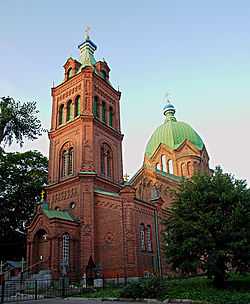Maskavas Forštate
Maskavas Forštate (English: Moscow Suburb; also Maskačka) is an old Riga neighbourhood situated on the right bank of the river Daugava. This neighborhood is located to the south of the old City of Riga along the road connecting Riga to Moscow, from which its name is derived.
History
The history of Maskavas Forštate district goes back to at least 14th century - this could be the second oldest urban part of Riga after Old City. Up to this day in some places the medieval street network has been preserved.
Maskavas Forštate has many inhabitants from south-eastern Latvia and also quite many from Belarus and Russia. Their influence can be seen in the local architecture - there are many Russian elements, wooden houses often have ornaments characteristic for Russians and Belarusians.
During the Nazi occupation of Riga, the neighborhood was turned into a ghetto for Jews. Today, there are memorials on the site of the synagogue and the old Jewish cemetery. Most of the prewar buildings remain standing.
Safety
Average level of criminal offences
Maskavas Forštate district has an average level of criminality along with the Centre and Old Riga. Ministry of the Interior Statistic[1] Riga is divided into 9 districts with the following levels of criminality:
- 2 HIGH (more than 2900 criminal offences). Located in the periphery of Riga.
- 4 AVERAGE (between 2100 and 2700 criminal offences). Centre, Old Riga, Maskavas Forštate.
- 3 LOW (less than 1700 criminal offences). Purvciems, Mežaparks (One of the wealthier areas of Riga).
In the past, Maskavas Forštate was the most dangerous district in Riga, which is the reason for many stereotypes. But new buildings, offices, shops, migration of local families has made the district’s improvement possible.
A further development of Maskavas Forštate was limited due to it being awarded “Protected Heritage” status, which is the reason why the old wooden houses are still in the area. Today, some renovations of wooden houses have been undertaken.
Although Maskavas is now safe, there is sometimes a feeling of insecurity created by the ambience of old wooden houses not renovated, especially for tourists from Western Europe.
Based on the number of criminal offences against foreigners, Maskavas Forštate is the 3rd safest district in Riga (out of 9 districts) according to statistics from the Latvian Ministry of the Interior.[1]
Points of interest
- It's the only district of Riga where churches of 5 different confessions are located.
- The Jesus Church is the biggest wooden building in Latvia.
- Grebenshikov's old-believer preaching-house is the biggest in the world.
- The Oldbeliever's church is the only gold-plated Oldbeliever's church in the world.
- The Central market, which at the start of the 20th century was the biggest and most modern market in Europe.
In popular culture
Some scenes in the television adaptation of the Robert Harris novel Archangel, starring Daniel Craig, were filmed on Maskavas Iela and Katolu Iela.
Gallery
-

Hay Market - one of the historical centres of Maskavas Forštate.
-

St. Francis Catholic church and school
-

The only gold-plated Oldbeliever's church in world
-

All Saints Orthodox Church
-

Maskavas Street - main axis of the district
-

View of the oldest preserved building in Maskavas Forštate from the spire of the Academy of Science - Orthodox church
References
- ↑ 1.0 1.1 Ministry of the Interior Statistic year 2008
External links
| Wikimedia Commons has media related to Maskavas Forštate. |
- Riga historical encyclopaedia
- Latgale suburb area history in Latvian language
- The Virtual Jewish History Tour History of the Riga ghetto
- Video
| ||||||||||||||||||||||||||||
Coordinates: 56°56′04″N 24°08′43″E / 56.93444°N 24.14528°E